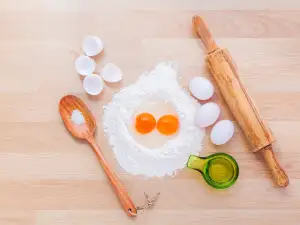Decoding the Egg Roll vs Spring Roll: Unraveling the Delicious Differences

Egg rolls and spring rolls are two popular dishes in Asian cuisine that often confuse people due to their similar appearance. While they may look alike, these delectable treats have distinct differences in terms of their ingredients, cooking methods, and regional variations. In this article, we will unravel the delicious differences between egg rolls and spring rolls, helping you understand and appreciate these culinary delights on a whole new level. So let's dive in and explore the world of egg rolls and spring rolls!
Definition of egg rolls
Definition of Egg Rolls:
Egg rolls are a popular Chinese-American dish that consists of a crispy, deep-fried wrapper filled with a savory mixture. The name "egg roll" is derived from the fact that the traditional filling includes scrambled eggs. However, modern variations often omit the eggs and focus on a combination of vegetables, meat, and sometimes noodles. The filling is typically seasoned with soy sauce, ginger, garlic, and other spices to enhance its flavor. Egg rolls are known for their cylindrical shape and golden-brown exterior, which provides a satisfying crunch when bitten into. They are commonly served as appetizers or as part of a larger meal.
Definition of spring rolls
Definition of Spring Rolls:
Spring rolls are a popular dish in many Asian cuisines, known for their delicate and light flavors. Unlike egg rolls, spring rolls are typically made with a thin rice paper wrapper. These translucent wrappers are made from rice flour and water, giving them a slightly chewy texture when cooked.
Inside the spring roll wrapper, you'll find an assortment of fresh vegetables such as carrots, cabbage, bean sprouts, and sometimes mushrooms or bamboo shoots. These vegetables are usually thinly sliced or julienned to create a crisp and crunchy filling.
Spring rolls are often enjoyed in their vegetarian form, but they can also be filled with shrimp, chicken, or tofu for added protein. The filling is usually seasoned with soy sauce, garlic, ginger, and other aromatic spices to enhance the flavors.
One key characteristic of spring rolls is that they are typically served cold or at room temperature. This makes them a refreshing appetizer or snack during hot summer months. The coolness of the filling combined with the crispy texture of the wrapper creates a satisfying contrast in every bite.
Overall, spring rolls offer a lighter and fresher alternative to egg rolls. Their emphasis on fresh vegetables and delicate flavors make them a popular choice for those seeking a healthier option without compromising on taste.
Wrapper differences
One of the key distinctions between egg rolls and spring rolls lies in their wrappers. Egg rolls are typically made with a thicker, dough-like wrapper that is crispy when fried. These wrappers are made from wheat flour, water, and sometimes eggs, giving them a slightly chewy texture.
On the other hand, spring rolls feature a thinner and more delicate wrapper that becomes translucent when cooked. These wrappers are commonly made from rice flour or a combination of rice and tapioca flour. The result is a light and crispy wrapper that adds a delightful crunch to the filling.
The difference in wrappers also affects the cooking methods used for each type of roll. Egg rolls are traditionally deep-fried to achieve their golden brown and crispy exterior. This frying process allows the thicker wrapper to cook thoroughly while retaining its crunchiness.
In contrast, spring rolls can be cooked through various methods such as deep-frying, shallow-frying, or even steaming. The thinness of the wrapper means it cooks quickly and easily absorbs flavors from the filling without becoming overly greasy.
While both types of rolls have distinct textures due to their different wrappers, they each offer a unique eating experience. Whether you prefer the satisfying bite of an egg roll or the delicate crispness of a spring roll, these variations in wrappers contribute to the overall enjoyment of these delicious treats.
Filling variations
Filling variations are where the egg roll and spring roll truly diverge. Egg rolls typically contain a savory mixture of diced vegetables such as cabbage, carrots, and bean sprouts, along with meat like pork or chicken. Some variations even include shrimp or tofu for added flavor and texture.
On the other hand, spring rolls often feature a lighter and fresher filling. They commonly include a combination of julienned vegetables like carrots, bell peppers, and cucumbers. Fresh herbs like mint, cilantro, and basil are also added to enhance the taste. Spring rolls can be enjoyed as a vegetarian option or with the addition of cooked shrimp or chicken.
The difference in fillings is what gives each roll its unique taste profile. While egg rolls offer a heartier and more robust flavor, spring rolls provide a refreshing and vibrant burst of flavors from the fresh vegetables and herbs.
Whether you prefer the richness of an egg roll or the lightness of a spring roll, both options offer endless possibilities for customization. From adding different spices to experimenting with various protein choices, you can create your own signature filling that suits your taste buds perfectly.
Cooking methods
Cooking methods play a crucial role in differentiating egg rolls from spring rolls. Egg rolls are typically deep-fried until they turn golden brown and crispy. This cooking method gives them a delightful crunch and locks in the flavors of the filling.
On the other hand, spring rolls are often either deep-fried or lightly pan-fried. The choice of cooking method depends on personal preference and regional variations. Pan-frying spring rolls results in a slightly softer texture with a delicate crispness, while deep-frying offers a more robust crunch.
Both cooking methods have their merits, providing unique textures and flavors to these beloved dishes. Whether you prefer the extra crispiness of deep-fried egg rolls or the lighter touch of pan-fried spring rolls, both options offer a satisfying culinary experience.
Regardless of the cooking method chosen, it is important to ensure that the oil used is hot enough to quickly seal the wrappers and prevent them from becoming greasy. The right temperature is key to achieving perfectly cooked egg rolls or spring rolls that are evenly golden and irresistibly delicious.
Experimenting with different cooking methods can add an exciting twist to your culinary adventures. So whether you're frying up some egg rolls for a party or preparing delicate spring rolls for a light lunch, don't be afraid to explore various techniques to find your perfect balance of taste and texture.
Regional variations
Regional variations in egg rolls and spring rolls add a delightful twist to these beloved dishes. In Chinese cuisine, egg rolls are commonly filled with a combination of vegetables, meat, and sometimes shrimp. They are then deep-fried until crispy and golden brown. In contrast, spring rolls from Southeast Asia often feature a lighter and fresher filling of herbs, vermicelli noodles, and vegetables like lettuce and bean sprouts. These are typically wrapped in rice paper and served fresh or lightly fried for added crispness. Vietnamese spring rolls, known as "Goi Cuon," often include ingredients like pork, shrimp, and mint leaves for an extra burst of flavor. Meanwhile, Thai spring rolls called "Poh Pia Tod" may contain unique ingredients such as glass noodles or even fruits like mango for a sweet twist. Each region showcases its own distinct flavors and techniques when it comes to these delectable treats.
Popular accompaniments
Popular Accompaniments:
Both egg rolls and spring rolls are often served with a variety of delicious accompaniments that enhance their flavors. These accompaniments can vary depending on regional preferences and personal taste. Here are some popular options:
1. Dipping Sauces: A common accompaniment for both egg rolls and spring rolls is a flavorful dipping sauce. Some popular choices include sweet and sour sauce, soy sauce, peanut sauce, or plum sauce. These sauces add an extra layer of tanginess or spiciness to the rolls.
2. Pickled Vegetables: Pickled vegetables such as carrots, radishes, or cucumbers are often served alongside egg rolls and spring rolls. The tangy and crunchy texture of pickles complements the softness of the rolls, adding a refreshing element to each bite.
3. Fresh Herbs: Fresh herbs like cilantro, mint, or Thai basil are commonly used as garnishes for egg rolls and spring rolls. These herbs provide a burst of freshness and aroma that elevates the overall flavor profile of the dish.
4. Lettuce Leaves: Some people enjoy wrapping their egg rolls or spring rolls in lettuce leaves before taking a bite. This adds a crisp texture to each mouthful while also providing a light and refreshing contrast to the savory fillings.
5. Noodles or Rice: In certain regions, it is common to serve egg rolls or spring rolls with noodles or rice on the side. This creates a more substantial meal and allows for different flavor combinations when enjoyed together.
Remember, these accompaniments are not set in stone – feel free to experiment with different combinations to find your own perfect pairing! Whether you prefer a spicy dipping sauce or enjoy the freshness of herbs, there's no shortage of options to enhance your enjoyment of these delectable treats.
In conclusion, the egg roll and spring roll may appear similar at first glance, but they are distinct in their own delightful ways. The egg roll boasts a crispy, golden-brown exterior with a savory filling, while the spring roll showcases a translucent wrapper and fresh ingredients. The cooking methods also differ, with egg rolls typically deep-fried and spring rolls often being steamed or fried. Regional variations add even more diversity to these beloved dishes. Whether you prefer the bold flavors of Chinese egg rolls or the lightness of Vietnamese spring rolls, both offer a satisfying culinary experience. Don't forget to pair them with popular accompaniments like sweet and sour sauce or peanut dipping sauce for an extra burst of flavor. So next time you're craving some Asian cuisine, remember to decode the egg roll vs spring roll debate and savor every delicious bite!
Published: 03. 12. 2023
Category: Recipes



